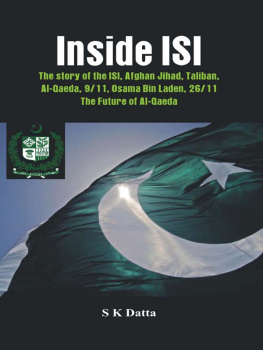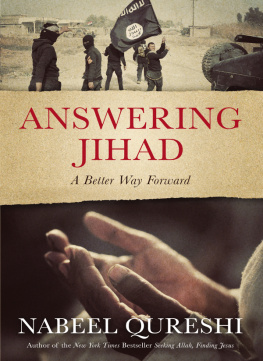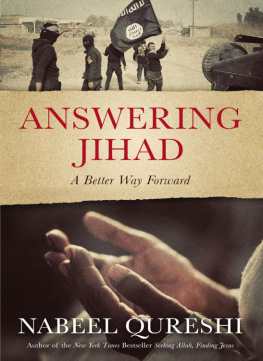Nasiri - Inside the jihad: my life with Al Qaeda: a spys story
Here you can read online Nasiri - Inside the jihad: my life with Al Qaeda: a spys story full text of the book (entire story) in english for free. Download pdf and epub, get meaning, cover and reviews about this ebook. City: New York;Great Britain;Afghanistan;Pakistan, year: 2007;2012, publisher: Basic Books, genre: Art. Description of the work, (preface) as well as reviews are available. Best literature library LitArk.com created for fans of good reading and offers a wide selection of genres:
Romance novel
Science fiction
Adventure
Detective
Science
History
Home and family
Prose
Art
Politics
Computer
Non-fiction
Religion
Business
Children
Humor
Choose a favorite category and find really read worthwhile books. Enjoy immersion in the world of imagination, feel the emotions of the characters or learn something new for yourself, make an fascinating discovery.
Inside the jihad: my life with Al Qaeda: a spys story: summary, description and annotation
We offer to read an annotation, description, summary or preface (depends on what the author of the book "Inside the jihad: my life with Al Qaeda: a spys story" wrote himself). If you haven't found the necessary information about the book — write in the comments, we will try to find it.
Nasiri: author's other books
Who wrote Inside the jihad: my life with Al Qaeda: a spys story? Find out the surname, the name of the author of the book and a list of all author's works by series.
Inside the jihad: my life with Al Qaeda: a spys story — read online for free the complete book (whole text) full work
Below is the text of the book, divided by pages. System saving the place of the last page read, allows you to conveniently read the book "Inside the jihad: my life with Al Qaeda: a spys story" online for free, without having to search again every time where you left off. Put a bookmark, and you can go to the page where you finished reading at any time.
Font size:
Interval:
Bookmark:
Copyright 2006 by Omar Nasiri
Published by Basic Books, A Member of the Perseus Books Group
All rights reserved. Printed in the United States of America. No part of this book may be reproduced in any manner whatsoever without written permission except in the case of brief quotations embodied in critical articles and reviews. For information, address Basic Books, 387 Park Avenue South, New York, NY 100168810.
Books published by Basic Books are available at special discounts for bulk purchases in the United States by corporations, institutions, and other organizations. For more information, please contact the Special Markets Department at the Perseus Books Group, 2300 Chestnut Street, Suite 200, Philadelphia, PA 19103, or call (800) 255-1514, or e-mail .
Interior design by Cynthia Young
In the course of this book, the names of several characters have been changed along with identifying details. A very small number of non-essential facts have also been altered.We have restricted these changes to only those cases in which their revelation would jeopardize the safety of the author, members of his family, secret service officers, as well as the secrecy of ongoing intelligence operations.
A CIP catalog record for this book is available from the Library of Congress.
Hardcover: ISBN-10: 0-465-02388-6; ISBN-13: 978-0-465-02388-2 Paperback: ISBN-10: 0-465-02389-4; ISBN-13: 978-0-465-02389-9
10 9 8 7 6 5 4 3 2 1

Although no Americans play a role in Mr. Omar Nasiris Inside the Jihad, the book is of immense interest and value to all Americans and Westerners in general. Indeed, it is not too much to say that with this book, Mr. Nasiri throws Americans a life preserver that may prevent them from drowning in the sea of deliberate misinformationfrom both Democratic and Republican political leadersconcerning their Islamist enemies.
U.S. and Western readers of Inside the Jihad will be struck by the complete lack of animosity Mr. Nasiri and the other mujahidin in the book have toward American and Western citizens and their cultures, freedoms, and liberties. Simply put, readers will find no Islamist fighter ready to kill himself because of early presidential primaries in Iowa or because the European Union mandates gender equality and homosexual rights. The reason people still believe Islamists are motivated by this kind of ephemera is due mainly to fifteen-plus years of lies from Americas bipartisan governing elite. These are lies based on that elites fear of the negative electoral impact of a domestic debate focused on the genuine motivation of the mujahidinan intense and still-building hatred for the content and impact of interventionist U.S. foreign policies in the Islamic world. The frantic eagerness of the U.S. governing elite to ignore the irrefutable evidence Mr. Nasiri provides in his book is evident today in the effort by the 2008 Republican presidential candidates to ostracize and silence fellow candidate Congressman Ron Paul (R-Texas). Mr. Paul is the only candidate to accurately identify the Islamists motivation as being in large measure a reaction to a half-century of U.S. political, economic, and military intervention in the Muslim world. Mr. Paul has not denigrated America by saying this; but by forthrightly stating a plain-but-painful fact, American political elites have branded him a simpleton, a defeatist, and a traitor.
Mr. Nasiri, by his own personal example, also serves as a salutary warning to Americans and Westerners. At the beginning of his journey into Al Qaedas organization, Mr. Nasiri is hardly an Islamist firebrand. He is actually a streetsmart, Brussels-based Moroccan citizen, with a pronounced taste for wine, cigarettes, and women; and he has a talent for criminal activity, particularly the illegal procurement of weapons. He decides to become a mujahid not from Islamist fervor, but because he betrayed a cell of Islamists in Belgiuma cell that included his brotherand needed to leave Europe for his own safety. Mr. Nasiri turns to the French external intelligence service for help and volunteers to penetrate the Afghan training camps on its behalf. The French take a chance on him and provide funding for his endeavor, but they strongly doubt his chances of success. The French were in for a surprise.
Entirely through his own efforts, and after several false starts, Mr. Nasiri travels to Pakistan and works his way into this well-established system, managed by Abu Zubayda, through which would-be mujahidin are vetted for security risks and then shuttled into one of several Al Qaeda training camps in Afghanistan. Mr. Nasiris street smarts, quick thinking, and acting ability beats the vetting process, and he enters the training program at Khaldan Camp, one of Al Qaedas premier training facilities. It is worth pausing for a moment to note several points detailed in the book that contradict the common wisdom of Western terrorism experts. First, Mr. Nasiri worked his way into Al Qaeda, he was not recruited. This fact suggests that we may be mistaken in looking for major Islamist recruiting stations in Western mosques; the self-recruitment of individuals traveling alone or in pairs to regions where a jihad is being waged may be far more common. Second, Mr. Nasiri achieved his success from 1995 to 1996, six years after the USSRs defeat in Afghanistan and four years after Osama bin Laden left that country for the Sudan. And yet, Mr. Nasiri found that the defeat of the Red Army and the Afghan communist regime and the temporary departure of Al Qaedas chief had sapped neither the martial motivation of the Islamists nor their ability to elicit sufficient funds from donors to keep the camps humming. In his book, Mr. Nasiri shows that Al Qaedas camps operated with great efficiency throughout the period between 1989 and bin Ladens return to Afghanistan in May 1996; Nasiri also shows that Al Qaedas body of trained fighters steadily expanded during this period. Finally, Mr. Nasiri encountered a range of nationalities training at the campsincluding Kashmiris, Chechens, Central Asians, and Eritreansthat was broader than many in the West believed at the time, suggesting that the Islamists jihad had gone global more than a decade ago.
Once inside Khaldan Camp, and later at Darunta Camp, Mr. Nasiri provides a riveting, and what for Westerners should be a profoundly unsettling description of the quality military training he received, as well as the type of quick-learning individuals he trained with. From Makarov pistols, AK-47 assault rifles, and heavy machine guns to rocket-propelled grenade launchers, plastic explosives, land mines, and Soviet T55 tanks, Mr. Nasiri and his classmates had hands-on training with virtually every item in the inventory of small arms and explosives produced by the former Soviet Union and its Eastern Bloc allies. And there was never any lack of ammunition for training purposes; the reader will find no ammunition shortages in Nasiris account and will read about what at times seems like profligate expenditures of explosives such as TNT, Semtex, and C4, and assorted munitions. We never had to conserve ammunition, Mr. Nasiri joyously writes, and there was always something new [in terms of weaponry] to try. Mr. Nasiri and his class also were given hands-on training with a number of U.S.- and Western-made weapons, and he received detailed classroom lectures on how to use the weapons that were not available in the camps.
In addition to weapons training, Mr. Nasiri and his classmates were subjected to physical training that for the Western reader will resemble the rigorous training received by the U.S. Marines and U.S. and British Special Forces. Everyone in the camp runs everywhere. Carrying weapons, ammunition, and rockets to build strength and endurance, they run up and down mountains, through rock-strewn valleys, and across icy rivers. They train in sweltering heat and frigid temperatures; moving at times barefoot, at others shod; and they work in both daylight and the dead of night. In short, the novice
Font size:
Interval:
Bookmark:
Similar books «Inside the jihad: my life with Al Qaeda: a spys story»
Look at similar books to Inside the jihad: my life with Al Qaeda: a spys story. We have selected literature similar in name and meaning in the hope of providing readers with more options to find new, interesting, not yet read works.
Discussion, reviews of the book Inside the jihad: my life with Al Qaeda: a spys story and just readers' own opinions. Leave your comments, write what you think about the work, its meaning or the main characters. Specify what exactly you liked and what you didn't like, and why you think so.










